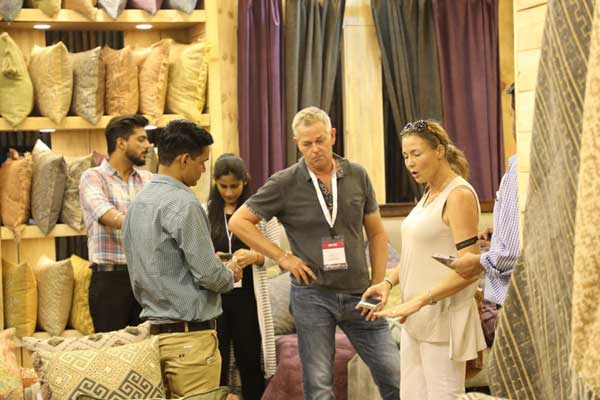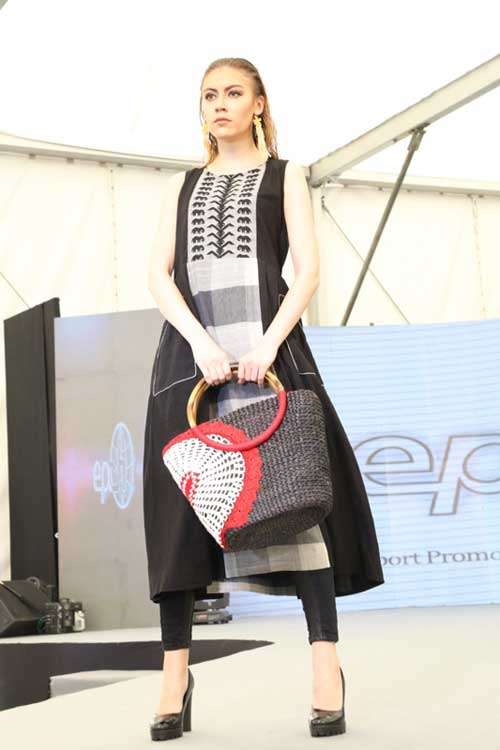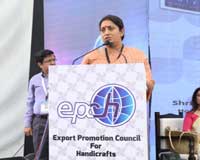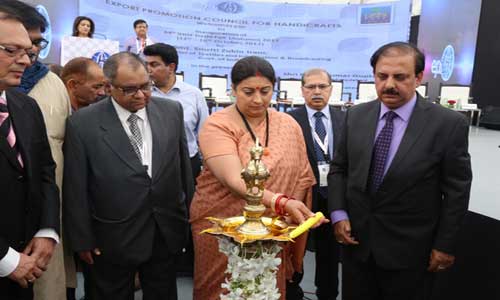FW
The second day of IHGF added glamour with business with the organisation of a fashion show on the products being displayed by the participants.

The companies whose products were modeled on the ramps included bags from Veva Fashion, Jaipur, leather bags from MB Exports, Rajasthan, jewelry from FDDI Footwear Institute, Noida, and dresses from the north eastern region.

Buyers from different countries were also seen busy doing business with exhibitors on the second day of the fair.

IHGF, the world’s largest handicrafts and gifts fair, is being held in Greater Noida, October 12 to 16, 2017.
A large number of overseas buyers are present at the fair. About 2980 exhibitors of home, lifestyle, fashion, textiles and furniture are participating. Over 6000 buyers from 110 countries are visiting the fair. Special attractions of this fair include a designer forum and recycled products.

The handicraft sector in India has witnessed a growth of 13.15 per cent in 2016-17 compared to the previous year.
EPCH supports the education of children of artisans through open schools which includes tuition fees and other study material. Seventy-five per cent of the entire expenditure will be borne by EPCH and 25 per cent by member exporters sponsoring the study of the children.
EPCH has a design register scheme under which member exporters can register their design without any hassle. EPCH design services are expected to augment the exports of handicrafts from the country and ultimately increase employment opportunities for artisans.
EPCH is providing full support through its integrated program of development of handicrafts and handloom of the north east which includes design, market and skill development.
A initiative is being taken for foreign direct investment in the handicrafts sector and joint venture opportunities for buyers and sellers i.e. both exporters and importers. Over 100 stakeholders have shown keen interest in the sector. A very large amount of investment from the US and Europe is already taking place in the handicrafts sector in China, South Korea, and Vietnam, which are competitors of India. This initiative will give opportunities to overseas buyers to bring technical knowhow, investment and their marketing network to form joint ventures for promoting Indian handicrafts in the world market. This is expected to give exports of handicrafts a new dimension.
Amazon has signed an MoU with the Telangana Department of Handlooms and Textiles to help handloom clusters in Warangal, Pochampally. As the number of weavers has increased over the years sales haven’t gone up proportionally. Warangal has been making durries that use cotton and jute for 40 years. Durries have kalamkari patterns on them. Warangal durries or rugs have been famous for many reasons such as they are made using vegetable colours, and are washed in flowing water after the printing process.
Pitta Ramulu was also the first weaver to get a national award, he had won the ‘National Handloom Award’ for 2015. Ramulu’s durries can be now found on Amazon.Ramulu is hoping the number of orders increases. Orders haven’t picked up much. So far, he has got a few orders through Amazon.
As per the Handloom Export Promotion Council, Warangal has been a long-standing centre for durries and 80 per cent of the handwoven durries sold in European and American markets are woven in India. In March 2016, the Telangana State Handicrafts Development Corporation tied up with Amazon India to sell local hand-made ‘Golkonda’ handicraft products. Many weavers are also registered on the India Handmade Bazaar, a portal sponsored by the Government of India, which also sells Indian handlooms and handicrafts.
This is only one amongst the many initiatives that have been picked up to get more handicrafts and handlooms online and available to a larger group of people, including the Tribal Cooperative Marketing Development Federation of India Limited, a PSU under the Ministry of Tribal Affairs.
Currently, there are about 24 weaver associations and societies who have registered on Amazon to sell their wares.
With cotton being one of the top polluting industries, a world first Australian technology could contribute a positive change in the global $500 billion textile and fashion markets. Australian company Nanollose has raised $5,000,000 from investors, with ambitions to commercialise its sustainable fibre technology after an IPO on the Australian Securities Exchange expected for October 18.
Nanollose CEO Alfie Germano says this mark an exciting time for the company, with its world first Plant-Free Cellulose fibre set to potentially become a sustainable alternative to commonly used but environmentally damaging fibres such as cotton.
Currently, cellulose is obtained from plant sources like cotton, wood and bamboo, with the supply chains and procurement ecosystems of these industries raising ever-growing environmental concerns.
Germano who has held multiple VP positions at some of the largest global apparel brands including Gap recently stated that the funds will be used to accelerate the development of the company’s fibre technologies and build production supply chains with key partners, who will license and grow the fibre. The funds will accelerate the development and get a point where it could offer the fibre as a sustainable alternative to that of fibres derived from cotton and wood. He further adds that progressive brands and companies are starting to facilitate this new shift by involving themselves deeper in the supply chain and searching for feasible, sustainable long-term alternatives, and wants to be part of the solution. The reason is to feed sustainable alternative into the global industries with little to no retrofitting to existing machinery or processes.
Germano’s first target is the $500 billion global textile industry, and says there is increasing urgency from brands, retailers and manufacturers to seek and cultivate alternative fibre resources.
Average synthetic fiber prices increased sharply in September. Global synthetic fiber prices increased 17.5 per cent year on year and by 5.8 per cent over the prior month. Contributors to the price increases included constraints on supply, a temporary spike in oil prices and disruption in intermediates product resulting from hurricanes, and continued Chinese crackdown on violations on environmental regulations.
Although oil prices have already settled down from their hurricane-related increases, delays in expansion of resin capacity in the US and Europe have caused concern over polyester supply in both the short and the long term. In Asia, the largest manufacturing region for synthetic fibers, the price increase was felt most intensely. Prices increased in September by 24 per cent year-over-year and 9.4 per cent month-over-month. The biggest increase was in the polyester filament area. Nylon textile filament costs were similarly affected, though not as dramatically. Spandex, viscose and acrylic staple prices remained relatively stable. Asian synthetic fiber prices remain more than 20 per cent below the global average.
In the US, prices rose by 6.9 per cent compared to September last year and three per cent from August. In Europe, prices rose by 18.2 per cent year-over-year and two per cent from last month.
Levi Strauss has recorded seven per cent revenue increase in the third quarter. Direct sales to consumers grew by 16 per cent and wholesale revenue by four per cent. Revenue increases in the year’s first two quarters were four per cent and six per cent. Levi Strauss is the owner of brands Levi’s and Dockers.
The group also reported a 180 base-point increase in its gross margin. However, due to unfavorable exchange rate adjustments and a series of equity operations, Levi Strauss' net income was down ten per cent. The group’s EBIT was up one per cent compared to last year.
Despite the changes affecting retail, Levi Strauss has achieved profitable growth and is leveraging the strength of its diversified business and the confidence it has in its brands. Its advertising and media investment in the fourth quarter is growing exponentially. The launch of the jacket developed with Google, and the initiatives celebrating the 50th anniversary of the Trucker Jacket, reinterpreted by 50 celebrities, artists and influencers from around the world, will add great energy to the year-end for Levi’s.
The group has revised its guidance for the fiscal year 2017 as a whole, currently forecasting a growth between five per cent and six per cent.
Leather garment manufacturer Lanka Leather Fashion is committed to promoting sustainability. Not content to only negate its overall impact, LLF improves its environmental performance year-on-year, and has even managed to achieve a notable 16 per cent reduction on its carbon footprint with a 11 per cent increase in production as well.
Founded in 1981, Lanka Leather supplies to prominent high-street fashion brands such as Hugo Boss, Gerry Weber, Michael Kors and Taleco. The organisation’s leadership in reducing and compensating for its environmental impact is getting much deserved attention from key decision makers and stakeholders in its global supply chains.
The manufacturer holds the title of Carbon Neutral for the third year in a row. This was awarded by UK based Natural Capital Partners. Carbon Consulting Company has conducted an in-depth assessment of LLF’s greenhouse gas emissions. LLF then invested in a renewable energy project in Sri Lanka to obtain registered carbon credits through Natural Capital Partners.
High quality, sustained volumes and competitive pricing have been key factors contributing to the success of Sri Lanka’s footwear and leather products industry. High quality Sri Lankan leather goods in the range of leather gloves, travel bags, back packs, ladies’ handbags, jackets and small leather goods cater to niche international markets.
Indian textile exporters are facing difficult times. They have been facing subdued demand trends in the key importing countries as well as intense competitive pressures from nations such as Bangladesh and Vietnam. In addition, unfavorable currency movements and high raw material prices as well as the recent revision in duty drawback rates have only added to their woes.
The slowdown in apparel segment has mainly been on account of subdued demand conditions in the key textile-consuming regions of the United States and the European Union, which account for a majority of exports from India. This apart, cotton yarn exports have been under pressure on account of a decline in demand from China.
India is the worst-affected nation among cotton yarn suppliers to China. India’s share in China’s cotton yarn imports has fallen to eight per cent in the first quarter of fiscal 2018 vis-à-vis 20 per cent and 25 per cent in the first quarter of fiscal 2017 and the first quarter of fiscal 2016 respectively.
Pressures on textile exporters have become more severe with the strengthening of the rupee against currencies of key competing nations during the current calendar year which has reduced the competitiveness of Indian exporters.
Indian textile and clothing exports have stagnated during the last three years. One reason is the FTA/PTA competitive advantage gained by competing nations such as Bangladesh and Vietnam and the high tariff rates imposed on Indian textile and the clothing products in major textile markets such as the EU, the US, Canada and China.
So the industry has appealed to the Center to refund the accumulated input tax credit at the fabric stage in order to avoid cost escalation, encourage the Make in India initiative, reduce import of fabrics, avoid job losses etc. Certain GST anomalies need to be addressed on a war footing. The power loom sector and independent weaving units that produce over 95 per cent of the woven fabric are burdened with 18 per cent GST on yarn while the vertically integrated units do not have to face this problem as they need to pay 18 per cent GST for fibers and only five per cent GST on fabrics, and the cost difference works out to five per cent to seven per cent.
However, the entire cotton textile value chain and also all the textile job work come under the lowest and seamless slab of five per cent. The low rate will help protect the livelihood of over 40 million people involved in cotton farming and trading, make cotton the engine of growth for the Indian textile industry and clothe the people of the nation at an affordable cost.
In countries like Germany investment in technical textiles is 70 per cent of textile output but in India investment in the technical textile sector is only 10 per cent. The technical textile industry also has about nine per cent of the world’s total consumption manufactured in India.
Technical textiles offer several advantages in their functional aspects for improving health and safety, cost effectiveness, and durability and strength of textile material. In India, this sector is in its nascent stages while on the global stage it’s a multi-million dollar industry. A large number of technical textile products are consumed by different industries like automotive, healthcare, infrastructure, oil and petroleum, among others.
Indian companies have started producing technical textiles for the international market. Though at a nascent stage, technical textile production in India with the right investment and exposure will definitely compete with international production.
Indian companies have been introducing several new developments in textile technology. Indian companies are developing products using meta aramid, a textile produced in India which is made from a blend of materials which are environment friendly, lightweight and perform better than asbestos. These meta aramid products can replace the carcinogenic asbestos in the Indian industry which was claiming the lives of people using them.












